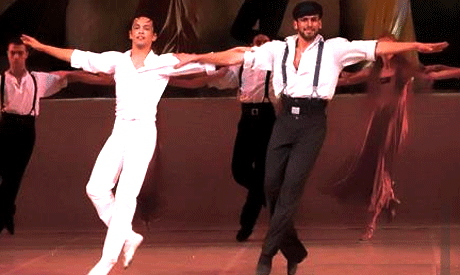Character Dance Classes
Bulgarian Traditional Folk Dance
Many Bulgarian dances are line dances, with the dancers holding hands in a straight or curved line, facing in toward the center of the dance space. Originally men and women danced in separate lines, or in a gender-segregated line in which the last woman and first man held opposite ends of a handkerchief.


List of Bulgarian folk dances
1.Pravo horo
2.Trite pati
3.Shopsko horo
4.Paydushko horo
5.Chetvorno horo
6.Rachenitsa
7.Elenino horo
8.Daychovo horo
9.Dunavsko horo

SIRTAKI GREEK DANCE
Sirtaki or syrtaki is a popular of Greek origin, choreographed by Giorgos Provias for the 1964 film Zorba the Greek. It is a recent Greek folkdance, and a mixture of the slow and fast versions of the hasapiko dance. The dance and the accompanying music by Míkis Theodorakis are also called Zorbá's dance, Zorbas, or "the dance of Zorba".

BELLY DANCE
Expressive dance which emphasizes complex movements of the torso.[1] Originally a Middle Eastern folk dance, it has evolved to take many different forms depending on the country and region, both in costume and dance style. New styles have evolved in the West as its popularity has spread globally.
POLKA DANCE
The polka is originally a Czech dance and genre of dance music familiar throughout Europe and the Americas. It originated in the middle of the 19th century in Bohemia, now part of the Czech Republic. Polka remains a popular folk music genre in many European countries.
UKRAINIAN DANCE
Traditional folk dances of the peoples of Ukraine.
Ukrainian Dance is often described as energetic, fast-paced, and entertaining, and along with traditional Easter eggs (pysanky), it is a characteristic example of Ukrainian culture instantly recognized and highly appreciated throughout the world.
RUSSIAN & SPANISH GYPSY DANCE
If you take a closer look at gypsy dancing in Europe, you will see that only three types that are well developed: Russian, Balkan and Spanish gypsy dances.The Russian gypsy dance is one of the most vibrant and expressive type of gypsy dances, along with Balkan and Spanish. The other gypsy groups, of course, also have their own dances, but these are less outstanding.
Female gypsy dance is followed by intricate footwork, arm movements, aberdevine, wide skirt swings, shoulder shimmies and floor work. This dance is characterised by a smooth slow start, then gradually tempo increases with the lush, fast ending. Russian gypsy dance appeared as the interpretation of Russian folk dance in the XIX century and since then has developed considerably, complemented also with other elements.
COUNTRY - WESTERN DANCE
COWBOY DANCE
Country/western dance, also called Country and Western dance, encompasses many dance forms or styles, which are typically danced to country-western music, and which are stylistically associated with American country and/or western traditions.






